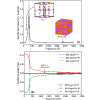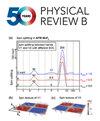Melting properties of the refractory metals V and W and the binary VW alloy fully from first principles
IF 3.7
2区 物理与天体物理
Q1 Physics and Astronomy
引用次数: 0
Abstract
We investigate the melting properties of the bcc refractory metals V and W, and the disordered equiatomic VW alloy from first principles. We show that thermal vibrations have a large impact on the electronic density of states (DOS) and thus considerably affect the electronic contribution to the free energy. For W, the impact of vibrations on the electronic free energy of solid and liquid is different. This difference substantially impacts the computed melting point and also triggers a large electronic heat capacity difference between solid and liquid. For V, although vibrations likewise affect the electronic free energy, the effect on the melting properties cancels out to a large degree. For the binary VW alloy we observe a similar impact as for W, but slightly weaker. The underlying physics is explained in terms of the electronic DOS of the solid and liquid phases. Based on our accurate first-principles results, we reveal critical limitations of the Sommerfeld approximation in predicting the electronic heat capacity difference between solid and liquid. Our results thus prompt us to scrutinize this approximation which is often used in phase diagram parametrizations in the CALPHAD approach, as well as for materials, such as W, that have a large electronic DOS difference between solid and liquid at the melting temperature.

从第一原理全面了解难熔金属 V 和 W 以及二元 VW 合金的熔化特性
我们从第一性原理出发,研究了 bcc 难熔金属 V 和 W 以及无序等原子 VW 合金的熔化特性。我们的研究表明,热振动对电子态密度(DOS)有很大的影响,从而大大影响了自由能的电子贡献。对于 W 来说,振动对固态和液态电子自由能的影响是不同的。这种差异对计算出的熔点有很大影响,同时也导致固态和液态之间的电子热容差异很大。对于 V 来说,虽然振动同样会影响电子自由能,但对熔化特性的影响在很大程度上被抵消了。对于二元 VW 合金,我们观察到的影响与 W 相似,但稍弱一些。我们从固相和液相的电子 DOS 角度解释了其基本物理原理。基于我们精确的第一原理结果,我们揭示了索默费尔德近似在预测固态和液态电子热容差方面的关键局限性。因此,我们的研究结果促使我们仔细审查这一近似值,因为它经常被用于 CALPHAD 方法中的相图参数化,以及 W 等在熔化温度下具有较大固态和液态电子 DOS 差异的材料。
本文章由计算机程序翻译,如有差异,请以英文原文为准。
求助全文
约1分钟内获得全文
求助全文
来源期刊

Physical Review B
物理-物理:凝聚态物理
CiteScore
6.70
自引率
32.40%
发文量
0
审稿时长
3.0 months
期刊介绍:
Physical Review B (PRB) is the world’s largest dedicated physics journal, publishing approximately 100 new, high-quality papers each week. The most highly cited journal in condensed matter physics, PRB provides outstanding depth and breadth of coverage, combined with unrivaled context and background for ongoing research by scientists worldwide.
PRB covers the full range of condensed matter, materials physics, and related subfields, including:
-Structure and phase transitions
-Ferroelectrics and multiferroics
-Disordered systems and alloys
-Magnetism
-Superconductivity
-Electronic structure, photonics, and metamaterials
-Semiconductors and mesoscopic systems
-Surfaces, nanoscience, and two-dimensional materials
-Topological states of matter
 求助内容:
求助内容: 应助结果提醒方式:
应助结果提醒方式:


